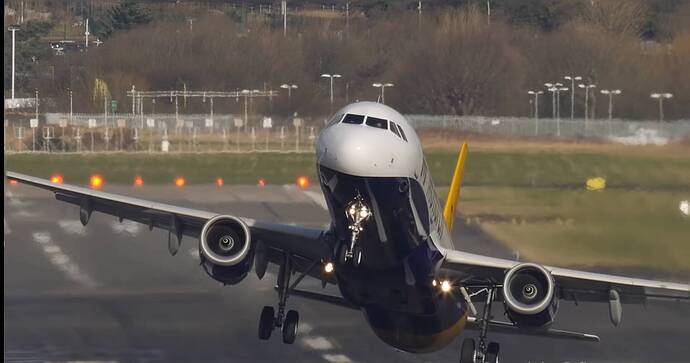You do, you fly with the nose “into wind” so to speak to maintain ground track (crabbing). Exactly as you said in the post I quoted, if the wind is from the right you will need the nose to be pointing to the right of the runway.
If in a light aircraft on approach some do choose to fly in side slip/wing low (like you did there with left rudder and right wing low for a wind from the right) which is a recognised technique but not as common in my experience.
Both ultimately achieve the same goal however, which is to have the aircraft moving diagonally through the airmass so that the ground track stays straight.
so if i fly level with let´s say 10 kts. xwind from the right, plane in trim, no controls touched, the plane would be “blown” to the right? to me that´s like a leaf being blown in the direction the wind comes from…
Point being: i KNOW i would turn the plane into the wind, but in this case i had to point it away to stay on track. Which brought me here, because obviously there were problems with wind directions in the past. That´s why that thread exists, obviously
1 Like
No, you aren’t quite getting it.
With respect to the ground, the plane in this scenario is being blown to the left.
So you have to fly diagonally right in the airmass to compensate for this left movement - how do you fly right? You point the nose to the right.
You are equating the nose pointing right relative to the runway with being blown to the right which is the opposite of what is happening.
Edit - perhaps there may be some confusion in multiple posts here but what I quoted (needing to point the nose to the right, or fly left rudder right wing low, with a wind from the right) is 100% correct behaviour.
exactely. so why did i have to apply left ail to stay on track?
Are you saying you had both left rudder AND left rudder, or did you have left rudder and right aileron to track the runway?
If it’s left for both, there is something wrong with your controls or trim, or the aircraft model perhaps… and it’s something I’ve never personally seen in the sim. Regardless of any wind conversation, left aileron and left rudder together should result in a strong continuous left turn and eventually potentially a spiral dive. There is no scenario in which that combination should result in flying straight relative to anything.
If it’s left rudder and right aileron to track the runway, that is what you would expect if trying to fly a sideslip approach with wind from the right.
The topic was about the wind socks pointing in the opposite direction. That´s why i came here, because that´s what i experienced.
normally planes don´t tend to fly towards the wind, but away from it. That´s what wind does (to my understanding) it blows things away from it, not sucking them towards it.
Thanks anyways.
They fly in the airmass. In order to keep flying straight relative to the ground they do indeed need to fly “towards” the wind by an amount proportional to how fast the airmass is moving.
One last time - to fly straight relative to the runway you will have to fly some degree into wind. For a wind from the right, that will end up with the nose needing to point to the right of the runway - ie pointing towards the wind.
If you aren’t seeing that behaviour (though the post I quoted suggests that’s exactly what you are seeing) then make sure you actually know where the wind is coming from, as said windsocks in MSFS apparently have been known to be incorrect and in any event only represent the wind on the ground which can be very different from the wind during the approach.
Point being, I’ve personally yet to see an aeroplane in MSFS not behaving broadly correctly in regards to actual wind direction.
It is worth pointing out all this changes once your on the ground.
On the ground the wind hitting the tail will weathervane the aircraft into the wind and you need opposite rudder to roll straight.
As far as crabbed landings and using rudder to align the nose as you touchdown, that is the way to go in airliners as they have the inertia to track the runway and slipping with a wing low runs the risk of a pod strike.
No problem at all,
i just remember my little plane kit with free propeller standing on roof and do turn toward wind, maybe classic example.
Well maybe it’s Just me, but applying the logic of this particular thread, the Wind in this picture (taken from YT) would be coming from the right (left from flightcrews’ View) which in my Humble opinion is Not the case, but which happened to me in-sim
Happy sunday, all
1 Like
for that id imagine wind was coming from pilot perspective to his right. angle towards the wind enough to keep it on course with the centre line.
If you angled the front away from the wind the plane would veer off to the pilots right and miss the centre line.
